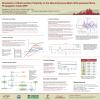Poster #203, Ground Motions
Toward development of physics-based coherency models using deterministic broad-band earthquake ground motion simulations
Poster Image:

Poster Presentation
2020 SCEC Annual Meeting, Poster #203, SCEC Contribution #10424 VIEW PDF
e difference code. We also use stochastic perturbations to model the small-scale geologic heterogeneity in the USGS 3D velocity model used in the simulations. We define a dense array with 0.1km spacing and compute the lagged coherency as a function of both distance and frequency. The analyses performed to-date suggest that: (1) the lagged coherency can decrease up to 60% in the frequency range of 0-4Hz and at a spatial distancing of less than 0.5km; (2) vertical components of the simulated ground motions show stronger incoherency compared to their horizontal counterparts; and (3) inclusion of small-scale stochastic perturbations in the velocity structure reduces the ground motion coherency.
SHOW MORE
SHOW MORE


















































